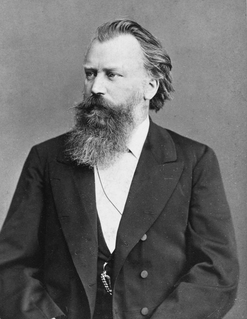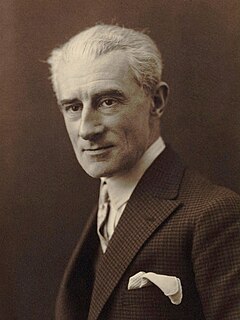Related Research Articles

The Concerto for Orchestra, Sz. 116, BB 123, is a five-movement orchestral work composed by Béla Bartók in 1943. It is one of his best-known, most popular, and most accessible works.

The Piano Concerto in A minor, Op. 54, by the German Romantic composer Robert Schumann was completed in 1845 and is the composer's only piano concerto. The complete work was premiered in Dresden on 4 December 1845. It is one of the most widely performed and recorded piano concertos from the Romantic period.

The Piano Concerto No. 2 in B♭ major, Op. 83, by Johannes Brahms is separated by a gap of 22 years from his first piano concerto. Brahms began work on the piece in 1878 and completed it in 1881 while in Pressbaum near Vienna. It took him three years to work on this concerto, which indicates that he was always self-critical. He wrote to Clara Schumann: "I want to tell you that I have written a very small piano concerto with a very small and pretty scherzo." Ironically, he was describing a huge piece. This concerto is dedicated to his teacher, Eduard Marxsen. The public premiere of the concerto was given in Budapest on 9 November 1881, with Brahms as soloist and the Budapest Philharmonic Orchestra, and was an immediate success. He proceeded to perform the piece in many cities across Europe.

Sergei Rachmaninoff's Piano Concerto No. 3 in D minor, Op. 30, was composed in the summer of 1909. The piece was premiered on November 28 of that year in New York City with the composer as soloist, accompanied by the New York Symphony Society under Walter Damrosch. The work has the reputation of being one of the most technically challenging piano concertos in the standard classical piano repertoire.

The Piano Concerto No. 5 in E-flat major, Op. 73, known as the Emperor Concerto in English-speaking countries, is a concerto composed by Ludwig van Beethoven for piano and orchestra. Beethoven composed the concerto in 1809 under salary in Vienna, and he dedicated it to Archduke Rudolf, who was his patron, friend, and pupil. Its public premiere was on 28 November 1811 in Leipzig, with Friedrich Schneider as the soloist and Johann Philipp Christian Schulz conducting the Gewandhaus Orchestra. Beethoven, usually the soloist, could not perform due to declining hearing.

Maurice Ravel's Piano Concerto in G major, was composed between 1929 and 1931. The concerto is in three movements, with a total playing time of a little over 20 minutes. Ravel said that in this piece he was not aiming to be profound but to entertain, in the manner of Mozart and Saint-Saëns. Among its other influences are jazz and Basque folk music.
Symphony No. 3 was Aaron Copland's final symphony. It was written between 1944 and 1946, and its first performance took place on October 18, 1946 with the Boston Symphony Orchestra performing under Serge Koussevitzky. If the early Dance Symphony is included in the count, it is actually Copland's fourth symphony.
The Piano Concerto No. 3 in E major, Sz. 119, BB 127 of Béla Bartók is a musical composition for piano and orchestra. The work was composed in 1945 during the final months of his life, as a surprise birthday present for his second wife Ditta Pásztory-Bartók.

The Viola Concerto in A minor, Sz. 120, BB 128 was one of the last pieces written by Béla Bartók. He began composing his viola concerto while living in Saranac Lake, New York, in July 1945. The piece was commissioned by William Primrose, a respected violist who knew that Bartók could provide a challenging piece for him to perform. He said that Bartók should not "feel in any way proscribed by the apparent technical limitations of the instrument"; Bartók, though, was suffering from the terminal stages of leukemia when he began writing the viola concerto and left only sketches at the time of his death.
The Young Person's Guide to the Orchestra, Op. 34, is a 1945 musical composition by Benjamin Britten with a subtitle Variations and Fugue on a Theme of Purcell. It was based on the second movement, "Rondeau", of the Abdelazer suite. It was originally commissioned for the British educational documentary film called Instruments of the Orchestra released on 29 November 1946, directed by Muir Mathieson and featuring the London Symphony Orchestra conducted by Malcolm Sargent; Sargent also conducted the concert première on 15 October 1946 with the Liverpool Philharmonic in the Philharmonic Hall, Liverpool, England.
Sergei Rachmaninoff composed his Piano Concerto No. 1 in F♯ minor, Op. 1, in 1891, at age 17-18. He dedicated the work to Alexander Siloti. He revised the work thoroughly in 1917.

The Concerto in D major for Oboe and Small Orchestra, AV 144, TrV 292, was written by Richard Strauss in 1945. It was one of the last works he composed near the end of his life, during what is often described by biographers, journalists and music critics as his "Indian summer."

The Concerto for Piano and Orchestra in G minor, Op. 33, is the only piano concerto by Czech composer Antonín Dvořák. Written in 1876, it was the first of three concertos that Dvořák completed, followed by the Violin Concerto, Op. 53 from 1879 and the Cello Concerto, Op. 104, written in 1894–1895. The piano concerto is probably the least known and least performed of Dvořák's concertos.
The Piano Concerto No. 2 in G major, Sz. 95, BB 101 of Béla Bartók is a musical composition for piano and orchestra. The work, which was composed between 1930 and 1931, is notorious for being one of the most difficult pieces in the repertoire.
The Symphony for Cello and Orchestra or Cello Symphony, Op. 68, was written in 1963 by the British composer Benjamin Britten. He dedicated the work to Mstislav Rostropovich, who gave the work its premiere in Moscow with the composer and the Moscow Philharmonic Orchestra on 12 March 1964. The work's title reflects the music's more even balance between soloist and orchestra than in the traditional concerto format.
The Concerto in C minor for Piano, Trumpet, and String Orchestra, Op. 35, was completed by Dmitri Shostakovich in 1933. The concerto was an experiment with a neo-baroque combination of instruments.
William Walton's Cello Concerto (1957) is the third and last of the composer's concertos for string instruments, following his Viola Concerto (1929) and Violin Concerto (1939). It was written between February and October 1956, commissioned by and dedicated to the cellist Gregor Piatigorsky, the soloist at the premiere in Boston on 25 January 1957.
Benjamin Britten's Violin Concerto, Op. 15, was written from 1938 to 1939 and dedicated to Henry Boys, his former teacher at the Royal College of Music. It was premiered in New York on 29 March 1940 by the Spanish violinist Antonio Brosa with the New York Philharmonic conducted by John Barbirolli. A revised version of the concerto appeared in 1951, including alterations of the solo violin part prepared with the assistance of Manoug Parikian. It was performed by Bronislav Gimpel and the Royal Philharmonic Orchestra under Thomas Beecham.
Improvisations on an Impromptu of Benjamin Britten is an orchestral piece by William Walton. It was first performed by the San Francisco Symphony Orchestra, conducted by Josef Krips, on 14 January 1970. Its European premiere was at Benjamin Britten's Aldeburgh Festival in June of that year. The work has subsequently been recorded for commercial release.
References
- 1 2 Boosey and Hawkes website, cc 2012 Boosey and Hawkes, an Imagem company.
- 1 2 Music Web International, Michael Cookson.
- ↑ Mitchell, Donald; et al. (2004). Letters from a life: the selected letters and diaries of Benjamin Britten. University of California Press. p. 161. ISBN 0-520-24259-9.
- ↑ Burton, Anthony (2015). Notes to Chandos CD CHSA 5153 OCLC 914132812
- 1 2 "Benjamin Britten - Piano Concerto (Revised version)".
- ↑ "Sviatoslav Richter - Britten - Piano Concerto No 1 - Svetlanov". YouTube .
- ↑ "Prom 18: Mahler & Britten".